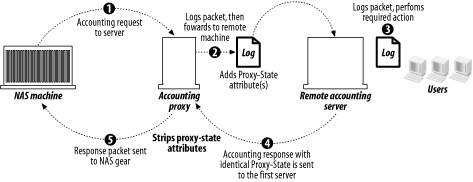| [ Team LiB ] |
|
4.2 Basic OperationAll communications regarding RADIUS accounting are done with an Accounting-Request packet. A client that is participating in the RADIUS accounting process will generate an Accounting Start packet, which is a specific kind of Accounting-Request packet. This packet includes information on which service has been provisioned and on the user for which these services are provided. This packet is sent to the RADIUS accounting server, which will then acknowledge receipt of the data. When the client is finished with the network services, it will send to the accounting server an Accounting Stop packet (again, a specialized Accounting-Request packet), which will include the service delivered; usage statistics such as time elapsed, amount transferred, average speed; and other details. The accounting server acknowledges receipt of the stop packet, and all is well. If the server does not or cannot handle the contents of the Accounting-Request packet, it is not allowed to send a receipt acknowledgment to the client. In this instance, the RFC recommends that a client continue to send its packets to the accounting server when it has not received an acknowledgment that its Accounting-Request packet has been processed. In fact, in large distributed networks, it is desirable to have several accounting servers act in a round-robin fashion to handle failover and redundancy needs. An administrator can carry this mentality further and designate certain accounting servers to handle different requests—one for his dial-up users, one for his DSL customers, and yet another for ISDN connections. Additionally, the proxy functionality present in the authentication and authorization realms of RADIUS are also allowed in the accounting phase, as the accounting server may make requests of other servers to assist in the processing of Accounting-Request packets. 4.2.1 More on ProxyingRADIUS accounting proxies act in much the same way as RADIUS authentication/authorization proxies do. Consider the following process:
Figure 4-1 shows the flow of this process. Figure 4-1. The proxying process for RADIUS accounting |
| [ Team LiB ] |
|